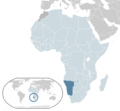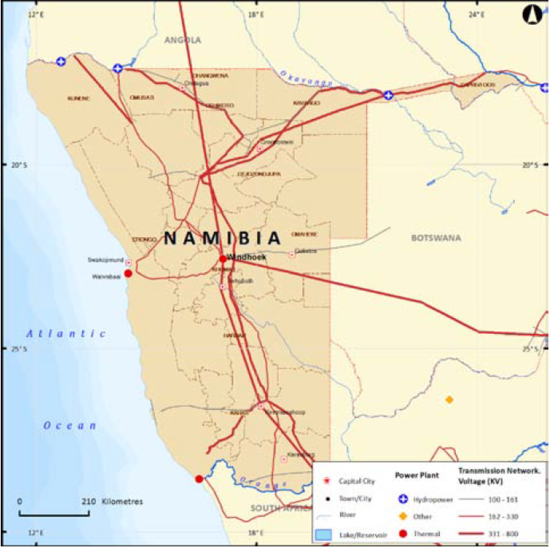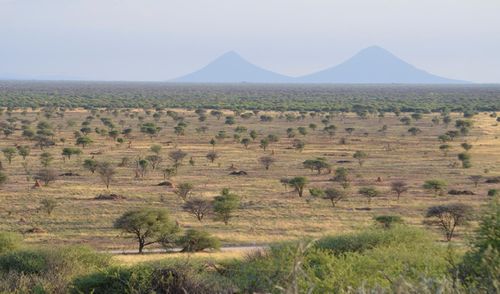Namibia Energy Situation
Capital:
Windhoek
Region:
Coordinates:
22.5700° S, 17.0861° E
Total Area (km²): It includes a country's total area, including areas under inland bodies of water and some coastal waterways.
824,290
Population: It is based on the de facto definition of population, which counts all residents regardless of legal status or citizenship--except for refugees not permanently settled in the country of asylum, who are generally considered part of the population of their country of origin.
2,567,012 (2022)
Rural Population (% of total population): It refers to people living in rural areas as defined by national statistical offices. It is calculated as the difference between total population and urban population.
46 (2022)
GDP (current US$): It is the sum of gross value added by all resident producers in the economy plus any product taxes and minus any subsidies not included in the value of the products. It is calculated without making deductions for depreciation of fabricated assets or for depletion and degradation of natural resources.
12,914,932,656 (2022)
GDP Per Capita (current US$): It is gross domestic product divided by midyear population
5,031.12 (2022)
Access to Electricity (% of population): It is the percentage of population with access to electricity.
55.23 (2021)
Energy Imports Net (% of energy use): It is estimated as energy use less production, both measured in oil equivalents. A negative value indicates that the country is a net exporter. Energy use refers to use of primary energy before transformation to other end-use fuels, which is equal to indigenous production plus imports and stock changes, minus exports and fuels supplied to ships and aircraft engaged in international transport.
74.44 (2014)
Fossil Fuel Energy Consumption (% of total): It comprises coal, oil, petroleum, and natural gas products.
66.72 (2014)
Introduction
Namibia lies in the southern part of the African continent. It borders the Atlantic Ocean to the west, Angola to the north, Zambia to the north-east, Botswana to the east, and South-Africa to both south-east & south.
Energy Situation
Overview of the Country's Energy Sources
Namibia's top energy sources are petroleum, hydropower, imported electricity, and imported coal[1]. The country's own internal resources supply less than one-third of its needed energy requirements[2].
Namibia has high potential for solar, wind and biomass generation[1]. Invade bush is widely spread in the country's northern parts, which allows a large scale bioenergy-based production capacity[3][1].
The country is also on the top 10 listed countries, which are in possession of uranium resources worldwide, and it solely supplies about 8.2% of the global uranium production[3].
Namibia's generated electricity comes mainly from a 240 MW hydroelectric power plant, a 120 MW coal-powered plant, and a 24 MW heavy fuel-oil powered plant[2].
Energy Access
There are around 1 million Namibians lack access to electricity, which means that almost half of the country is without access at all (~53% has access & ~47% has no access)[4][5].
According to the REN21-SADC Renewable Energy and Energy Efficiency Status Report (2018), the challenge in Namibia is to provide electricity access to the 79% of the rural and sparse population that does not have access by establishing feasible and maintainable off-grid solutions. The Rural Electricity Distribution Masterplan 2010 prioritises 2,879 rural localities to be electrified in the next 20 years and identifies 27 localities for off-grid electrification (including via renewables); however, implementation has been limited.[6]
So far the country has developed several pilot mini-grids, including three off-grid systems: Gobabeb, Tsumkwe Mini Grid and Gam Solar PV Mini Grid. In rural and remote areas where neither the main grid nor mini- grids are available, consumers depend on stand-alone electricity sources, mainly diesel generators. The use of solar technologies has been increasing, and hybrid solar/diesel systems have proved to be technically sound off-grid solutions.[7]
Production
Installed Capacity
Consumption
Namibia's average consumption rate surpasses 3000 GWh/year, while its generation capacity is around 1305 GWh/year[1]. Therefore, there is a supply gap, which is covered by importing power from South-Africa, Zambia, and Mozambique[1].
Most of the final consumed energy goes to the country's transport sector[1].
Import and Export
Electricity
Energy Security
Renewable Energy
Non-electricity off-grid renewable energy projects include the small/ micro wind energy installations used for water pumping, which are very common in Namibia, especially on farms. This technology has been used successfully for decades, with about 30,000 wind- driven water pumps installed in the country as of 2005; however, the current trend is to replace these with solar energy sources.[8]
Solar
The Solar Revolving Fund under the Ministry of Mines and Energy continues to subsidise stand-alone solar systems for individual household use: between 2015 and 2017, it financed some 1,600 solar systems (water heaters, pumps and solar home systems).
Hydropower
Bioenergy
EEP Africa supported a very successful biomass energy project that is harvesting invader bush – which covers substantial areas of northern Namibia – for use in a steam boiler. The project, Combating Bush Encroachment for Namibia’s Development, has installed a 250 kW bush-to electricity gasification pilot power plant on a commercial farm in the heavily bush-infested Otavi area. The plant, which was not yet operational as of mid-2018, is considered as a proof-of-concept project to determine the financial feasibility of this approach, assess the robustness of the technology and establish Namibia’s first IPP.
Fossil Fuels
Key Problems of the Energy Sector
Policy Framework, Laws and Regulations
Institutional Set up in the Energy Sector
Other Key Actors / Activities of Donors, Implementing Agencies, Civil Society Organisations
Further Information
- REN21, 2018. SADC Renewable Energy and Energy Efficiency Status Report (Paris: REN21 Secretariat) http://www.ren21.net/wp-content/uploads/2018/12/SADC_2018_EN_web.pdf
References
- ↑ 1.0 1.1 1.2 1.3 1.4 1.5 Munyayi, R. Chiguvare, Z. & Ileka, H. (2015). Fact Sheet on: Renewable Energy – Shifting Energy Systems in Namibia towards a More Sustainable Path. Retrieved from: https://www.thinknamibia.org.na/files/learn-and-engage/jtBTlZQO-YnHdSkT.pdf Cite error: Invalid
<ref>tag; name "Munyayi, R. Chiguvare, Z. & Ileka, H. (2015). Fact Sheet on: Renewable Energy – Shifting Energy Systems in Namibia towards a More Sustainable Path. Retrieved from: https://www.thinknamibia.org.na/files/learn-and-engage/jtBTlZQO-YnHdSkT.pdf" defined multiple times with different content Cite error: Invalid<ref>tag; name "Munyayi, R. Chiguvare, Z. & Ileka, H. (2015). Fact Sheet on: Renewable Energy – Shifting Energy Systems in Namibia towards a More Sustainable Path. Retrieved from: https://www.thinknamibia.org.na/files/learn-and-engage/jtBTlZQO-YnHdSkT.pdf" defined multiple times with different content - ↑ 2.0 2.1 Von Oertzen, D. (2010). Namibian National Issues Report on the Key Sector of Energy with a Focus on Mitigation. Retrieved from: https://www.undpcc.org/docs/National%20issues%20papers/Energy%20(mitigation)/15_Namibia%20NIP_energy%20mitigation.pdf
- ↑ 3.0 3.1 Lund, H.G. & Mabirizi, F. (2017). Atlas of Africa Energy Resources. Retrieved from: https://www.icafrica.org/fileadmin/documents/Publications/Africa_Energy_Atlas.pdf
- ↑ Central Intelligence Agency (CIA). (2019). The World Fact-book: Africa: Namibia. Retrieved from: https://www.cia.gov/library/Publications/the-world-factbook/geos/wa.html
- ↑ Tracking SDG7. (2019). Namibia. Retrieved from: https://trackingsdg7.esmap.org/country/namibia
- ↑ Ministry of Mines and Energy of the Government of Namibia, Implementation of the Off-Grid Energisation Master Plan (OGEMP) http://www.mme.gov.na/files/publications/541_off-grid-masterplan.pdf
- ↑ European Union Energy Initiative Partnership Dialogue Facility (EUEI PDF) and Regional Electricity Regulators Association of Southern Africa (RERA), Supportive Framework Conditions for Mini-grids Employing Renewable Energy and Hybrid Generation in the SADC Region. Namibia Case Study: Gap Analysis and National Action Plan (Eschborn, Germany: December 2013), http://www.euei-pdf.org/sites/default/files/field_publication_file/SADC_RERA_Case_Studies.zip .
- ↑ Danish Ener gy Management & Esbensen, Renewable Energy Market Landscape Study Covering 15 Countries in Southern and East Africa. Volume II. Country Profiles, Stakeholder Maps (August 2017), p 32 https://www.entwicklung.at/fileadmin/user_upload/Dokumente/ Regionen/Volume_II_Market_Landscape_-Study_-EEP-SEA_Country - Profiles_StakeholderMaps-1.pdf























